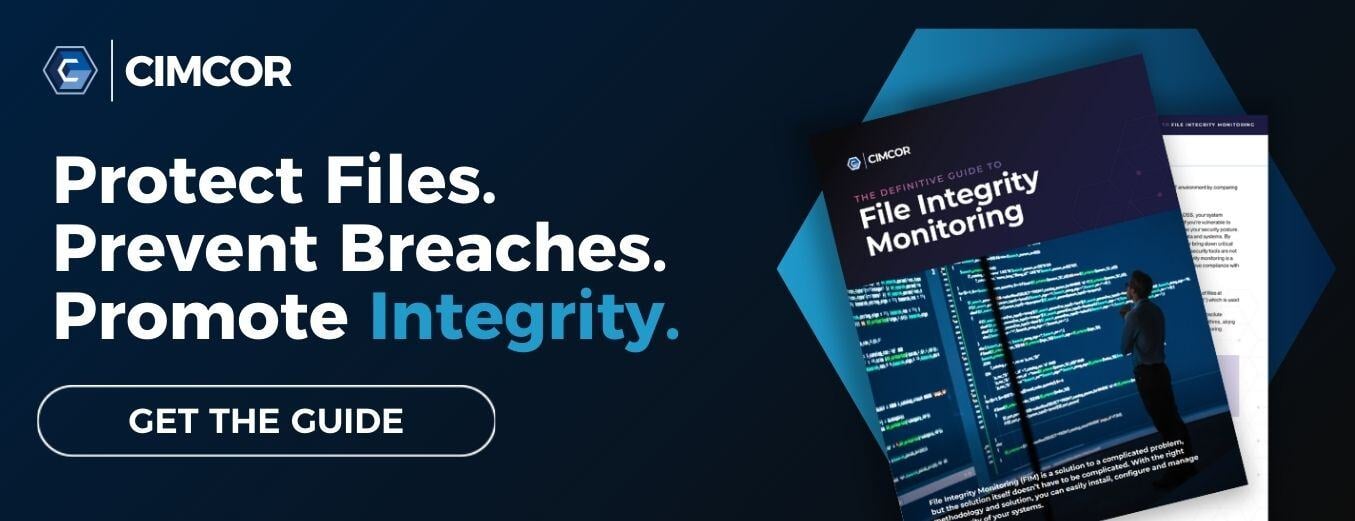File integrity monitoring (FIM) software remains one of the most critical elements for maintaining compliance and system resilience across various frameworks, including PCI-DSS, NIST 800-53, and HIPAA. As changes occur to critical systems and devices, it's possible to become non-compliant with PCI standards in seconds.
Your organization's network is dynamic, which is why organizations today need solutions that work in real-time to measure compliance and eliminate security risks. However, before you embark on your compliance journey, it's important to understand the basics of file integrity monitoring and how it works.
What is File Integrity Monitoring?
At its core, File Integrity Monitoring (FIM) is a cybersecurity process that detects unauthorized changes to critical files, configurations, or settings. It compares the current state of a system against a known-good baseline and alerts administrators whenever something unexpected occurs.
Among the enterprise solutions on the market, there are subtle, significant differences in features and functionality. In this guide, you'll see how enterprise-grade FIM solutions function, why agent-based solutions remain dominant, and what benefits modern integrity tools offer.
Agentless and open-source options may sound appealing, but they often lack the ability to quantify true ownership costs or provide comprehensive visibility. Think of it like getting a puppy for "free". The initial cost is low, but the ongoing maintenance (bedding, toys, food, veterinary bills, etc.) and responsibilities are what really add up.
For a deeper comparison of deployment methods, we recommend: Agent-Based vs. Agentless File Integrity Monitoring: Which is Best?
What Does a File Integrity Monitoring Tool Do?
A FIM solution provides organizations with continuous visibility into what's changing across their IT environment, effectively helping teams detect unauthorized or unexpected activity before it becomes a serious incident.
By focusing on the benefits of file integrity monitoring, we'll examine the role it can play in your organization and how it can positively affect your security objectives. Here's what robust, enterprise-level FIM tools like CimTrak provide:
- IT Environment Monitoring: Depending on your FIM product or service, you should gain the ability to monitor files, users, groups—your entire IT environment. This may include the state of your:
- Servers
- Network devices
- Critical workstations
- Cloud environment
- Point of sale systems
- Port settings
- Databases
- VMware
- Hypervisor/ESXI
- Active Directories/LDAP
- Real-Time Notification: Through a centralized management portal, you should receive real-time alerts of changes made on critical systems and devices across your entire IT environment.
- Total Change Management: While most agent-based FIMs do not offer this capability, CimTrak is unique in its ability to support total change management directly from the FIM management portal. This gives admin users the ability to prevent changes entirely and/or remediate and roll back to any number of established and trusted baselines.
- Change Documentation and Logging: Enterprise FIM provides in-depth logs of all changes, including expected and authorized changes. This supports the daily audit of logs and internal reporting. It can also provide sufficient documentation for forensic investigation or other situations where you need to access historical records.
- Differentiate Changes: CimTrak is the only file integrity monitoring tool with a built-in workflow and ticketing system, providing an automated change reconciliation process. This allows users to identify unknown, unwanted, and unauthorized changes in real-time.
Key Benefits of File Integrity Monitoring
Implementing a robust FIM solution can help your organization:
- Mitigate the risk of integrity drift
- Detect Zero-Day attacks early
- Reduce operational and forensic costs
- Automatically remediate unwanted and unauthorized changes
- Achieve continuous compliance with 25% of all IT compliance mandates on average
How File Integrity Monitoring Works
FIM works by detecting changes to files, configurations, and settings. When you initially install FIM, it creates a baseline to determine your trusted point of reference. That baseline uses cryptographic hashes that are essentially unique fingerprints. When a hash changes, it can be determined that the original files being monitored have been altered in some way.
 More robust enterprise solutions, like CimTrak, work at the OS kernel level to detect changes in real-time. In contrast, open-source, agentless, or older FIM tools rely upon continuously scanning for change. This difference makes the CimTrak agent very lightweight, with minimal impact on processor utilization.
More robust enterprise solutions, like CimTrak, work at the OS kernel level to detect changes in real-time. In contrast, open-source, agentless, or older FIM tools rely upon continuously scanning for change. This difference makes the CimTrak agent very lightweight, with minimal impact on processor utilization.
If a difference is detected between the state and baseline, this is registered as a change, and an alert can be generated, or a workflow process can be initiated to determine whether the change was good or bad. If your FIM has advanced situational intelligence, your alert will also include human-readable insight into the specifics of changes.
Three Primary Components of FIM
- A Database: This database stores information on the original state of your files and configurations as cryptographic hashes. Advanced FIM solutions also store the original file(s) to initiate a roll-back to restore to a previous baseline of operation.
- Agents: These technical components measure the state of systems and devices for change and upload that information to the database for comparison and analysis.
- User Interface: Typically, administrative users utilize a centralized web portal as the hub for change management, change control analysis, reporting/alerting, and remediation.
Other Elements of File Integrity Monitoring Tools
Dashboards
If your organization chooses to divide security responsibilities among multiple personnel, you can create customized dashboards and access permissions in the management console to provide up-to-date information on the area of your network or environment relevant to each individual's area of responsibility. Enterprise FIM tools should enable multi-tenancy capability.
Integration with Complementary Tools
Enterprise FIM solutions can integrate with complementary platforms such as Security Information and Event Management (SIEM), Security Orchestration, Automation, and Response (SOAR), and IT Service Management tools. These integrations streamline alerting, automate response actions, and provide unified visibility across ops and security functions. For example, CimTrak's integrations allow security teams to tie integrity data into existing workflows (such as incident response, vulnerability management, and compliance reporting), ensuring continuous integrity across both IT and OT environments.
Why FIM Remains Critical for Compliance and Resilience
Today's cyber threats exploit change: configuration drift, unauthorized updates, and insider actions that erode system trust. File Integrity Monitoring provides a layer of assurance that every modification is accounted for, documented, and, if necessary, reversible.
Whether the goal is protecting critical infrastructure, meeting regulatory requirements, or improving operational control, effective FIM practices give organizations real-time visibility into change and the confidence to maintain a trusted state across complex environments.
Next Steps: Strengthen Your Integrity with Next-Gen FIM
Next-Gen file integrity monitoring allows your organization to utilize and incorporate a plethora of other integrity controls to drive unprecedented security results and statistics. By understanding the full scope, benefits, and potential of this new advanced technology, information security professionals can understand and be alerted to more than just determining when a file has changed (as highlighted on a PCI checklist or other similar compliance requirements).
Click here to learn more about how CimTrak can benefit your organization with best-of-class change detection, configuration management, change reconciliation, and remediation.

October 28, 2025




